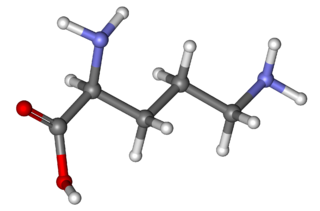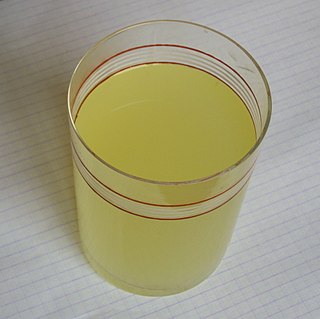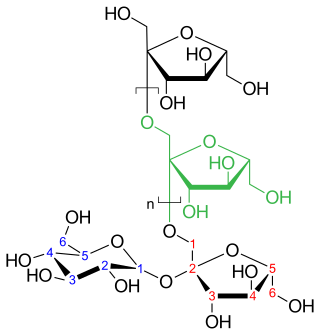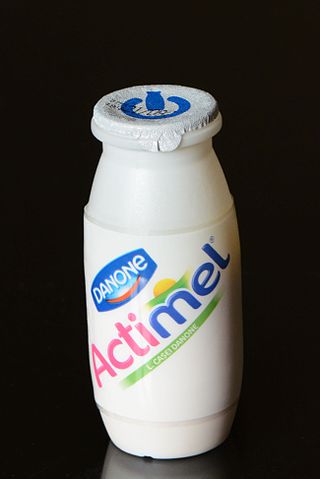
Monosodium glutamate (MSG), also known as sodium glutamate, is the sodium salt of glutamic acid. MSG is found naturally in some foods including tomatoes and cheese in this glutamic acid form. MSG is used in cooking as a flavor enhancer with an umami taste that intensifies the meaty, savory flavor of food, as naturally occurring glutamate does in foods such as stews and meat soups.

Ornithine is a non-proteinogenic amino acid that plays a role in the urea cycle. Ornithine is abnormally accumulated in the body in ornithine transcarbamylase deficiency. The radical is ornithyl.

Whey is the liquid remaining after milk has been curdled and strained. It is a byproduct of the manufacturing of cheese or casein and has several commercial uses. Sweet whey is a byproduct resulting from the manufacture of rennet types of hard cheese, like cheddar or Swiss cheese. Acid whey is a byproduct brought out during the making of acid types of dairy products, such as strained yogurt.

Inulins are a group of naturally occurring polysaccharides produced by many types of plants, industrially most often extracted from chicory. The inulins belong to a class of dietary fibers known as fructans. Inulin is used by some plants as a means of storing energy and is typically found in roots or rhizomes. Most plants that synthesize and store inulin do not store other forms of carbohydrate such as starch. In the United States in 2018, the Food and Drug Administration approved inulin as a dietary fiber ingredient used to improve the nutritional value of manufactured food products. Using inulin to measure kidney function is the "gold standard" for comparison with other means of estimating glomerular filtration rate.

Human height or stature is the distance from the bottom of the feet to the top of the head in a human body, standing erect. It is measured using a stadiometer, in centimetres when using the metric system or SI system, or feet and inches when using United States customary units or the imperial system.
Auxology is a meta-term covering the study of all aspects of human physical growth. Auxology is a multi-disciplinary science involving health sciences/medicine, and to a lesser extent: nutrition science, genetics, anthropology, anthropometry, ergonomics, history, economic history, economics, socio-economics, sociology, public health, and psychology, among others.
Food intolerance is a detrimental reaction, often delayed, to a food, beverage, food additive, or compound found in foods that produces symptoms in one or more body organs and systems, but generally refers to reactions other than food allergy. Food hypersensitivity is used to refer broadly to both food intolerances and food allergies.

Maltitol is a sugar alcohol used as a sugar substitute and laxative. It has 75–90% of the sweetness of sucrose and nearly identical properties, except for browning. It is used to replace table sugar because it is half as energetic, does not promote tooth decay, and has a somewhat lesser effect on blood glucose. In chemical terms, maltitol is known as 4-O-α-glucopyranosyl-D-sorbitol. It is used in commercial products under trade names such as Lesys, Maltisweet and SweetPearl.
The relationship between alcohol and weight is the subject of inconclusive studies. Findings of these studies range from increase in body weight to a small decrease among women who begin consuming alcohol. Some of these studies are conducted with numerous subjects; one involved nearly 80,000 and another 140,000 subjects.

Actimel is a probiotic yogurt-type drink produced by the French company Danone.

Hypouricemia or hypouricaemia is a level of uric acid in blood serum that is below normal. In humans, the normal range of this blood component has a lower threshold set variously in the range of 2 mg/dL to 4 mg/dL, while the upper threshold is 530 μmol/L (6 mg/dL) for women and 619 μmol/L (7 mg/dL) for men. Hypouricemia usually is benign and sometimes is a sign of a medical condition.
Nutrient density identifies the amount of beneficial nutrients in a food product in proportion to e.g. energy content, weight or amount of perceived detrimental nutrients. Terms such as nutrient rich and micronutrient dense refer to similar properties. Several different national and international standards have been developed and are in use.
The insulin index of food represents how much it elevates the concentration of insulin in the blood during the two-hour period after the food is ingested. The index is similar to the glycemic index (GI) and glycemic load (GL), but rather than relying on blood glucose levels, the Insulin Index is based upon blood insulin levels. The Insulin Index represents a comparison of food portions with equal overall caloric content, while GI represents a comparison of portions with equal digestible carbohydrate content and the GL represents portions of a typical serving size for various foods. The Insulin Index can be more useful than either the glycemic index or the glycemic load because certain foods cause an insulin response despite there being no carbohydrates present, and some foods cause a disproportionate insulin response relative to their carbohydrate load.
EuroFIR is a non-profit international association, which supports use of existing food composition data and future resources through cooperation and harmonization of data quality, functionality and global standards.
Knemometry is the medical term for measuring the distance between knee and heel of a sitting child or adolescent using a technical device, the knemometer. Knemometric measurements show a measurement error of less than 160 μm (0.16 mm) and enable illustrating growth at intervals of few weeks.
SN2 Palmitate is a structured triglyceride where palmitic acid is bonded to the middle position (sn-2) of the glycerol backbone. Structured triglycerides are achieved through an enzymatic process using vegetable oils. Current usage of structured triglycerides is mainly for infant formula providing a human milk fat substitute.

Environmental enteropathy is an acquired small intestinal disorder characterized by gut inflammation, reduced absorptive surface area in small intestine, and disruption of intestinal barrier function. EE is most common amongst children living in low-resource settings. Acute symptoms are typically minimal or absent. EE can lead to malnutrition, anemia, Stunted growth, impaired brain development, and impaired response to oral vaccinations.
Nutrient profiling, also nutritional profiling, is the science of classifying or ranking foods by their nutritional composition in order to promote health and prevent disease. A common use of nutrient profiling is in the creation of nutritional rating systems to help consumers identify nutritious food.

Gianluca Tognon is an Italian food scientist, researcher, public health expert, author and speaker. In 2017 he has founded the consulting company The Food Scientist, which is based in Sweden.









